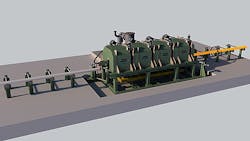TimkenSteel, SMS Prepping Breakthrough Quench/Temper Line
Specialty steelmaker TimkenSteel contracted SMS Meer to install a new heat-treatment plant at its Gambrinus Works in Canton, OH, a project previously announced as costing $40 million. The Advanced Quench and Temper Facility (AQTF) — which will be commissioned during Q2 2016 (rather than Q2 2015, as first reported) — is based on a design jointly developed by TimkenSteel and SMS Meer, one that combines induction preheating and heating furnaces for austenitizing and tempering 4- to 13-in. bar and tubular products. It “will set new performance standards among existing comparable facilities,” according to an SMS announcement.
SMS noted the AQTF has been in development and construction for a year and a half. The project was announced first last October, though the contract and design details have remained unreported until now. Heat treating is intended to add value to TimkenSteel’s current product lines, which include steels supplied to oil-and-gas exploration and transportation markets.
“Quench and temper” is a heat-treating process that produces steels with specific levels of mechanical strength. It starts with heating the steel bar or tube to a uniform temperature in a walking-hearth furnaces, usually over 1,500°F. This step is followed by quenching in a hot liquid (usually oil or water), or air, depending on the steel grade. The second step achieves the rapid cooling that imparts a high level of material hardness.
SMS Meer stated the core of the AQTF design will be a new water-spray system design called Quenching Shell®, which will be adjustable according to different products and adaptable to changing process conditions. The contractor explained that the Quenching Shell is “the result of intensive research and development work promising to become the next generation’s standard for similar applications.”
TimkenSteel was formed in June 2014 by The Timken Co. spinning off its steelmaking operations to shareholders. Those plants have been the objects of several capital-improvement programs over the past five years, including new ladle metallurgy and continuous billet casting capacity, and in-line forging capability to produce SBQ steel bars with improved center soundness.
"Our investment in additional value-added operations feeds growing sales of our most sophisticated product lines, which meet the needs of demanding applications in energy and other markets," stated Shawn J. Seanor, TimkenSteel’s exec. vice president for Energy and Distribution, speaking last October.
This report has been updated from an earlier version.
About the Author
Robert Brooks
Editor/Content Director - Endeavor Business Media
Robert Brooks has been a business-to-business reporter, writer, editor, and columnist for more than 20 years, specializing in the primary metal and basic manufacturing industries. His work has covered a wide range of topics including process technology, resource development, material selection, product design, workforce development, and industrial market strategies, among others.
Currently, he specializes in subjects related to metal component and product design, development, and manufacturing—including castings, forgings, machined parts, and fabrications.
Brooks is a graduate of Kenyon College (B.A. English, Political Science) and Emory University (M.A. English.)

